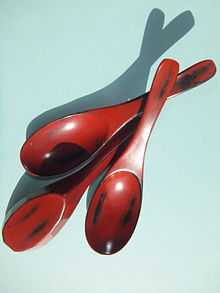Japanese lacquerware

Japanese lacquerware (historically referred to as Japan, analogous to Chinese ceramics) is a broad category of fine and decorative arts, as lacquer has been used in paintings, prints, and on a wide variety of objects from Buddha statues to bento boxes for food.
.jpg)
A number of terms are used in Japanese to refer to lacquerware. Shikki (漆器) means "lacquer ware" in the most literal sense, while nurimono (塗物) means "coated things", and urushi-nuri (漆塗) means "lacquer coating."
The sap of the lacquer tree, today bearing the technical description of "urushiol-based lacquer," has traditionally been used in Japan. As the substance is poisonous to the touch until it dries, the creation of lacquerware has long been practiced only by skilled dedicated artisans.
Lacquer has been found to have been used in Japan as early as 7000 BC, during the Jōmon period. Evidence for this was discovered at the Kakinoshima "B" Excavation Site in Hokkaido's Minamikayabe Town (北海道の南茅部町の垣ノ島B遺跡). Many traditional crafts and industrial arts produced throughout Japanese history were initially influenced by China, and afterward experienced various native stylistic influences and innovations over the centuries. The Edo period (1603–1868) saw an increase in the focused cultivation of lacquer trees and the development of the techniques used. In the 18th century colored lacquers came into wider use.
Techniques and processes
As in other countries where lacquerware has traditionally been produced, the process is fundamentally quite basic. An object is formed from wood, sometimes leather, paper, or basketry. Lacquer is applied to seal and protect the object, and then decoration is added. Generally, three coats (undercoat, middle-coat, and final coat) are used, the final coat sometimes being clear rather than black lacquer, in order to allow decorations to show through.
Alongside the red and black lacquers, it is common to see the use of inlay, often seashells or similar materials, as well as mica or other materials. The application of gold powder is known as maki-e, and is a very common decorative element.
A few examples of traditional techniques follow:
- Ikkanbari (一閑張), also known as harinuki (張貫) is one common technique used to make tea wares. Invented by Hiki Ikkan in the early 17th century, the process involves the application of layers of lacquer to paper shaped in a mold.
- Iro-urushi (色漆), literally "color lacquer", was created by adding pigments to clear lacquer. The limits of natural pigments allowed only five colors (red, black, yellow, green and brown) to be used up until the 19th century, when various innovations appeared, along with the later introduction of Western artificial pigments. Shibata Zeshin was a major innovator in this field, using not only color but also other substances mixed in with his lacquer to achieve a wide variety of effects, including the simulated appearance of precious metals, which were heavily restricted from artistic use at the time due to government concerns over excessive extravagance.
- Shunkei-nuri (春慶塗), supposedly developed by a 14th-century monk named Shunkei, was a popular method in the 17th century of using clear lacquer to allow the natural appearance of the wood underneath to show through.
Regional forms
As with most traditional arts, variations emerged over time as individual centers of production developed their own unique techniques and styles.
- Aizu wares developed in the late 16th century, and saw a peak in their production in the Meiji period. One Aizu technique is that of etching designs or images into the surface of the lacquer, and then filling in the space with gold or other materials. Other techniques distinctive of Aizu involve the burnishing of various clays and primers in the process.
- Jōhana wares are generally known for their use of maki-e and mitsuda-e (gold and lead decoration, respectively), and for the use of white or whitish lacquer.
- Negoro lacquerwares were produced at the Negoro-ji temple complex in Izumi province. The red layers of lacquer on Negoro wares are intended to gradually wear away with use, revealing the black lacquer underneath. This effect has since been copied and emulated elsewhere.
- Ryukyuan lacquerware, though frequently included among types of Japanese lacquer, actually developed largely independently, with strong influences from China and Southeast Asia, as the Ryukyu Islands did not come under Japanese control until 1609.
- Tsugaru wares feature a technique supposedly developed by Ikeda Gentarō at the end of the 17th century; multiple layers of different colored lacquers are used to create a colorful mottled effect.
- Wakasa wares are made using a variety of colors, and the inclusion of eggshells, rice chaff, or other materials in the base coats. Silver or gold foil is used as well, and sealed under a layer of transparent lacquer.
See also
- List of National Treasures of Japan (crafts-others)
- Raden
- Japanning: a term for a later European imitation of this technique, using plant resins to create a different type lacquer
External links
- Facing Modern Times - The Revival of Japanese Lacquer Art 1890-1950
- Bridge of dreams: the Mary Griggs Burke collection of Japanese art, a catalog from The Metropolitan Museum of Art Libraries (fully available online as PDF), which contains material on Japanese lacquerware
References
- Urushi-nuri at JAANUS.